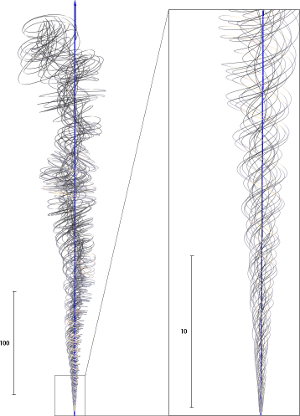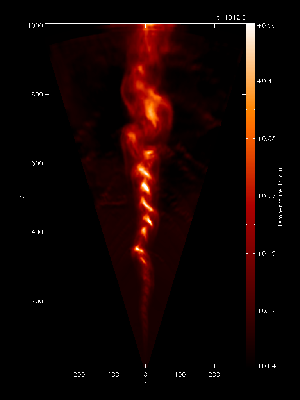|
|  |
Jet-shaped outflows of hot gas are quite common in the
Universe. Well-known examples can be found in so-called "active"
galaxies, in whose cores jets are formed and then travel enormous
distances. The length of the jet can be a billion times the size of
the core region in which it forms. The core region itself consists of
a supermassive black hole which devours matter through a so-called
accretion disk, getting even more massive in the process. A similar
situation can be found in protostars, where a new star grows out of a
hydrogen cloud, with the difference that the central object is not a
black hole, but the nascent star. Jets from such objects also cover
enormous distances of about a million times the distance between the
Earth and the Sun. Finally, there are jets which cannot be directly
observed, but which are linked to momentary bursts of short-wave
radiation, the so-called gamma ray bursts. Many of these events are
probably caused by a black hole with an accretion disk in the core of
a supermassive, rapidly rotating star at the end of its life.
A crucial role in the formation of jets is probably played by magnetic
fields that are anchored in the rotating central object, e.g. the
abovementioned accretion disk. The magnetic field gets helically
twisted by the rotation, inducing a force that accelerates the matter
within the jet. However, such jets are potentially unstable: small
"kinks" in the jet tend to become larger with time. This can go as far
as destroying the jet. Basically the same problem appears in
experiments of nuclear fusion.
With the new calculations, it was possible to reproduce jets in
simulations and follow their evolution up to a large distance from the
source. It turned out that jets are not necessarily destroyed by the
instabilities. Rather, wiggly structures are formed which are also
seen in observations of real jets. Part of the magnetic field gets
dissipated, i.e. it is "destroyed" and the energy stored in the field
is converted into heat. Such hot regions would appear as bright knots
in the observations.
The calculations have shown that for a simulation to be realistic the
jet has to be followed over a large distance. This requires the use of
powerful computers for a long time, a use of huge amounts of
resources. With continuing increases in computing power, there will be
opportunities for even bigger and better jet simulations.
Rainer Moll
Further Information:
R. Moll, H. C. Spruit & M. Obergaulinger,
"Kink instabilities in jets from rotating magnetic fields",
in Astronomy & Astrophysics, volume 492, pp. 621--630
|

